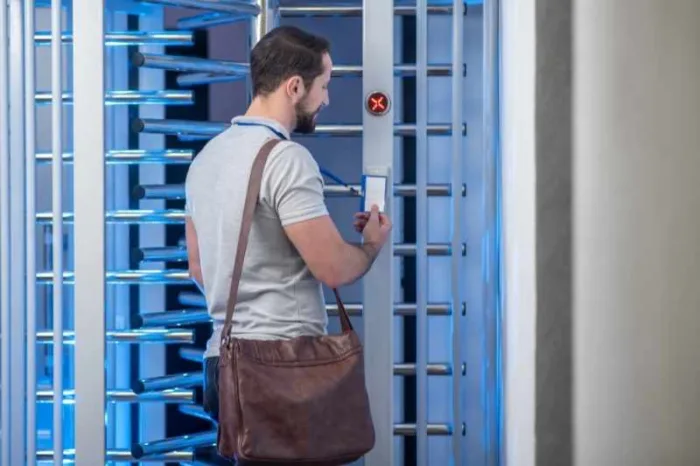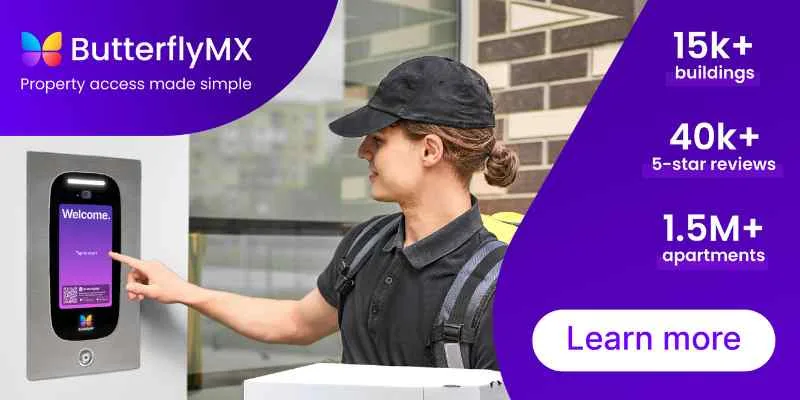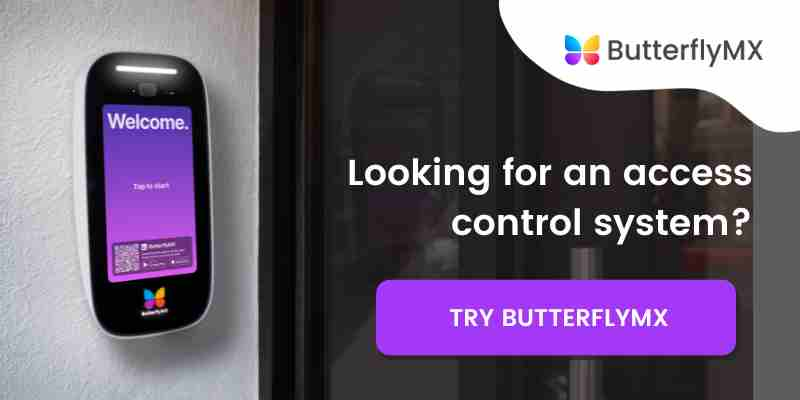Key takeaways
- Badge entry systems are a great alternative to traditional lock and key systems. However, the system still relies on a finicky, damage-prone, and easily lost ID card credential.
- Nowadays, smartphone-based access control systems eliminate the need for physical credentials.
- With a mobile-based access control system, your tenants gain access without compromising security.
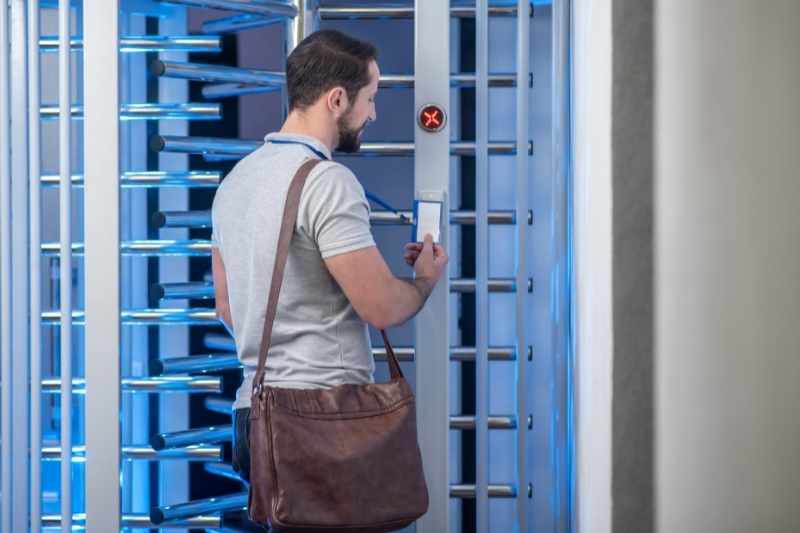
Does your property need a robust access control system? A badge entry system may be the perfect solution. Badge entry systems are a popular choice for residential, commercial, and industrial properties because they combine the need for both identification and entry credentials.
As a modern key card and key fob system, badge systems are an easy replacement for traditional locks and keys. In this guide, we review what badge door entry systems are and how they work. Then, we cover the pros and cons of badge entry systems. Finally, we offer a simpler, more reliable alternative to badge entry systems.
In this guide, we cover:
- What is a badge entry system?
- Types of badge credentials
- How do badge entry systems work?
- Use cases for office and employee badging systems
- Advantages & disadvantages of badge entry systems
- Visitor vs. employee badge systems
- A better alternative to badge entry systems
- Badge entry system FAQs
What is a badge entry system?
A badge entry system is an electronic building access control solution that authorizes access in and out of your building using a person’s ID badge as the credential. So, the badge is used for both visual identification and access authorization. As such, this type of system is popular with commercial and industrial properties.
You’ve likely seen badge entry systems before. Plenty of visual media portrays secret agents swiping ID cards to gain access to restricted areas. But, properties don’t need a top-secret entry security clearance to qualify for a swipe card access control system.
Properties like college campuses, hospitals, and office buildings commonly use badge entry systems for optimum security measures. Users simply swipe or scan their ID cards to gain access to a building and the rooms within.
Badge entry systems require three components:
- ID badge credential. Credentials for badge entry systems are ID cards with a built-in chip or magnetic stripe that transmits information to readers.
- Card reader. The tenant holds their ID badge up to an access reader. Then, the reader compares the received credentials with its database to verify the user’s identity and access permissions. Once their identity is verified, the card reader tells the door to unlock.
- Magnetic or electric door lock. Access control systems need a specialized door lock that magnetically or electrically unlocks when the reader approves entry.
Explore the differences between magnetic locks and electric locks:
How much do badge entry systems cost?
Badge entry systems cost between $1,200 and $2,500 per entry point, whether that’s at your front gate, your main property entrance, or interior doors.
So, the total cost depends on the number of entryways you need to secure, which may depend on the size of your property and the number of tenants in your building.
In an office or business setting, your badge system for employees must streamline access for your staff. So, you’ll have to purchase more ID cards as employees lose badges, need badge replacements, or leave the company. Also, the technology you choose to power your badge entry system will affect the final price.
Replacing an encrypted ID badge may cost as little as $10 if you outsource to a third party. However, if you choose to produce new badges in-house, the price for a printer and software quickly adds up. Employee ID printers and software range from $3,000 to $10,000.
Pro tip: Remember that the system cost doesn’t include installation fees. Make sure to hire a certified installer so that the system’s warranty remains valid.
Types of badge credentials
While all badge access door systems rely on ID card credentials, not all badges work the same way. Each type of badge uses a different type of technology to communicate with the access card reader and door lock.
Three examples of badge credentials are:
1. Swipe badges
Swipe ID badges use magnetic technology. Each ID has a magnetized stripe with a unique pattern. When tenants swipe their ID badges through an access reader, the system tells your door to open if it recognizes the magnetic stripe.
What’s more, the magnetic stripe on these badges can be wiped and rewritten. So if an employee changes departments and needs their credentials changed, they can keep their original ID card. You just have to reprogram their swipe cards to have the correct credentials. As a result, you negate the need for badge replacements.
2. RFID badges
ID cards with RFID (radio frequency identification) technology rely on radio waves embedded in the card. These cards are also called proximity cards, and they facilitate a contactless entry method. RFID card readers emit electromagnetic fields called excitation fields, creating a reading range from 2.5 inches to 20 feet wide, depending on the model.
Most RFID models consist of a standalone reader that is installed next to the door. However, RFID door locks with built-in RFID readers on door handles are also an option.
3. Scannable badges
Scannable ID badges are the most common type of ID badge credential since they’re the most affordable to make en masse. To create a scannable badge, you simply print a QR code on the front of an employee ID badge. To use it, employees hold their badge up to the access reader. If the QR code is authorized, they’re granted access.
However, because QR codes are easier to replicate than swipe or RFID badges, they pose a security risk. So, if your property requires strict security clearances, consider going with a more well-encrypted option.
How do badge entry systems work?
Using a badge entry system is simple, here’s how to use key card entry systems for businesses:
- Present credentials. First, tenants present their ID cards to the card reader. Typically, the card reader is installed next to your door. With swipe cards, tenants swipe their IDs through the reader. Meanwhile, tenants hold RFID and scannable cards near the reader.
- The card reader verifies credentials. Depending on the type of credential you install, there are several ways for card readers to verify credentials. For example, Wiegand access control systems use magnetized wires to transmit credentials. Conversely, other types of card readers, such as RFID systems, use an electric field emitted by the access reader to verify credentials. In all cases, the reader cross-references the information from the card with its databases.
- The card reader signals the door to unlock. Once your tenant’s credentials are verified, the card access reader signals your door to unlock.
Use cases for office and employee badging systems
Here are some common use cases for office and employee badging systems:
- Office suites
- Law offices
- Medical offices
- Coworking spaces
- Financial institutions and banks
- Schools, daycares, and campuses
Office suites
In shared office buildings, badge systems can segment access between different businesses and secure multi-tenant access control, which ensures that only authorized personnel enter specific office suites.
What’s more, tenants can customize access levels and assign varying access permissions to employees based on their roles. So you can grant some full building access while restricting others to specific floors or areas.
Additionally, offices can issue temporary digital badges to guests and facilitate seamless visitor management. So, you streamline the check-in process while maintaining building security.
Law offices
Because badge systems limit access to areas where sensitive client files are stored, they empower you to protect client confidentiality. As a result, only authorized legal staff enter private zones like document storage or case preparation rooms.
Employee entry logs provide a detailed audit trail for enhanced tracking and security purposes. So, you elevate security measures for confidential client records and ensure compliance with legal and ethical obligations.
What’s more, badge systems can reserve private conference rooms for legal consultations or depositions, giving staff exclusive access seamlessly.
Medical offices
Medical offices are responsible for safeguarding patient records and sensitive treatment areas. Fortunately, badge access control systems empower you to restrict access to healthcare personnel and authorized staff only to ensure HIPAA-compliant security.
What’s more, badge entry systems facilitate controlled access to medical equipment and labs. So, you ensure that only qualified doctors, nurses, or lab technicians access certain areas.
Additionally, in the event of an emergency, badging systems can provide real-time information on staff locations that improve evacuation procedures and patient safety.
Coworking spaces
Offer flexible membership access with badge systems that provide members with secure, personalized access to your space. This also makes it easy to customize tiered access permissions for premium services or meeting rooms.
What’s more, coworking access control offers streamlined guest access by issuing temporary badges that can be issued to visitors or event attendees.
Additionally, badging systems integrate with in-house cafes or amenities, allowing your members to make payments or book meeting spaces seamlessly.
Financial institutions and banks
Restrict access to sensitive areas by using badge systems to secure vaults, teller areas, and trading floors. As a result, you ensure only authorized personnel access these high-security zones.
More importantly, financial institutions must adhere to strict regulatory standards, and badge entry logs provide a valuable audit trail to prove compliance with access control policies.
Furthermore, badge entry stems empower you to control and manage visitor entry for clients and vendors by issuing temporary badges with limited permissions.
Schools, daycares, and campuses
Ensure student and faculty safety with badge systems that secure classrooms, labs, and faculty offices.
What’s more, schools and daycares can use badge systems to provide temporary access badges for parents, guest speakers, or maintenance staff, keeping your building safe while still allowing access as needed.
Moreover, badge systems track movement across buildings, improving overall campus security so you can respond quickly to emergencies or unauthorized entry.

Advantages & disadvantages of badge entry systems
We’ve covered what badge entry systems are and how they work. But what are the specific benefits and drawbacks of badge entry systems?
Although badge entry systems come with many benefits, there are some downsides you should be aware of before investing in one.
Advantages of badge entry systems
- Increased security. Building staff can monitor which doors are opened and, more importantly, who opened that door. This greatly improves security. Additionally, RFID and swipe badges can be deactivated if lost.
- Effective for multiple entry points. Most commercial and industrial buildings have multiple interior entrances with more restricted access than the main entrance. If installed throughout the whole property, a badge entry system prevents unauthorized visitors or tenants from entering restricted areas.
- Simplified access. Instead of fumbling around for a key, your tenants can swipe or hold their cards up to the reader. What’s more, you save money by eliminating the need to pay a security guard to verify each ID card.
Disadvantages of badge entry systems
- Unreliable. Because of their slim size and shape, ID cards are damage-prone. Additionally, interference from cell phones and magnets may damage swipe ID cards, making them nonfunctional.
- Expensive to replace. Although a single ID card costs as little as $10, that cost adds up quickly. Further, property staff will waste valuable time deactivating lost badges and programming or ordering new ones.
- Inconvenient for tenants. Unless tenants wear their ID cards as a part of their uniform, they’ll likely frequently forget to carry them every single time they leave the building.
- No visitor management. Unless tenants wear their ID cards as a part of their uniform, they’ll likely frequently forget to carry them every single time they leave the building.
Visitor vs. employee badge systems
Visitor badge systems
Visitor and employee badge systems serve distinct purposes within a property’s security framework. Visitor badge systems are designed for short-term use, providing temporary access to guests, contractors, or clients.
These badges typically restrict entry to common areas such as reception or meeting rooms and are configured to expire after a set time, ensuring that visitors can’t access sensitive or restricted zones.
Visitor badges streamline the check-in process and not only maintains a secure environment by limiting access but also aids in real-time monitoring by keeping an accurate log of all on-site visitors.
Employee badge systems
In contrast, employee badge systems are intended for long-term use by staff members and offer comprehensive and customizable access based on an individual’s role and responsibilities within your business.
These badges grant access to various parts of your property, from general office areas to highly secure locations like server rooms or executive offices. Employee badges usually have advanced security protocols, like multi-factor authentication, to protect sensitive information and areas.
Additionally, business access control systems often incorporate features like time and attendance tracking. What’s more, they seamlessly integrate with other workplace systems—like HR, facility management, and cashless payment services.
A better alternative to badge entry systems
It’s true that key card security systems for businesses are more convenient and cost-effective than hiring security guards to check every tenant’s ID card. However, relying on an ID badge entry system isn’t the best solution for property access. Instead, consider a mobile access control system that allows tenants to use their smartphones as credentials.
Smartphone-based entry systems maintain the same security as ID badge entry systems but present a more convenient entry method for tenants. Tenants can even grant visitors access remotely from a mobile app. Furthermore, building staff won’t waste time or money replacing or reprogramming ID badges. And tenants will be relieved that they don’t have to keep track of a small employee ID card for property access.
Invest in a mobile access control system consisting of:
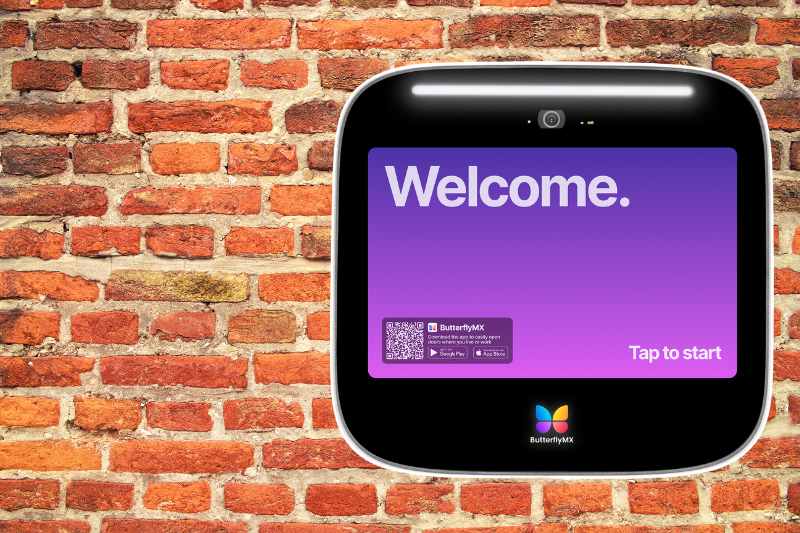
Video Intercom for your property entrance
Integrating an IP Video Intercom into your access control system allows tenants to gain property access via their smartphones. The best Video Intercoms offer features like Visitor Passes that give visitors an easy way to access the building.
Here are a few other features to look for in your access control system:
- Heightened visibility into all entry activity. A ButterflyMX Video Intercom provides an audit trail — with date- and time-stamped photos — of every door release to ensure top-notch security. This way, property staff can address unauthorized entries and other suspicious activities in real-time.
- Remote 24/7 access. Our cloud-based solutions empower you to grant, manage, and restrict access to your property with just a few clicks from anywhere in the world.
- Sleek and modern interface. Blending beauty with functionality, our Video Intercom elevates your building experience while also being simple to use.
Keypads for interior doors
Don’t make your tenants carry a large set of keys or wait for maintenance personnel to unlock doors to restricted areas. Instead, replace the physical lock with a keypad at each interior door.
ButterflyMX Keypads empower tenants to enter rooms using a unique PIN code or a swipe-to-open feature on the system’s mobile app. Our Keypad access control system also logs all entry activity, ensuring only authorized tenants enter restricted areas.
Discover how ButterflyMX works:
Badge entry system FAQs
Here are some commonly asked questions about badge entry systems:
What technology do badge readers use?
Badge readers use a variety of methods to identify and authenticate your users. The most common technologies are RFID, magnetized wires in magnetic stripe cards, QR codes, NFC (near field communication), and biometric readers.
Do badges use RFID?
Yes, RFID is one of many technologies commonly used in badges. However, not all badges use RFID technology.
